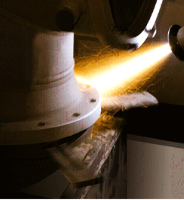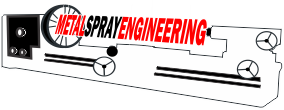Thermal Spray Nonskid Coatings
Nonskid coatings are sometimes used to prevent or reduce slip hazards. Aluminum thermal spray coatings have been used successfully on metal substrates to prevent corrosion and impart nonskid properties. Historically, paint coatings have been used for nonskid applications. However, because of their greater hardness and roughness, aluminum thermal spray coatings are superior for many nonskid applications. The nonskid coating system is achieved by first applying aluminum thermal spray system 8-A. An additional spray pass of aluminum is then applied using reduced atomization air pressure. The lower air pressure allows for the deposition of larger spray particles that produce a rougher surface. Nonskid coatings should be sealed with thin film epoxies. Aliphatic polyurethanes can be used for durable striping if desired. Some common applications for nonskid coatings and the recommended thermal spray coatings systems may be found in Table 5-3.
Thermal Spray Coatings for Cavitation/Erosion Protection
a. Cavitation repair and mitigation. For hydraulic components subject to low cavitation environments, Stellite 6 applied by the HVOF spray process may be used to mitigate and repair cavitation damage. The coating is applied to a thickness of 500 μm (0.020 in.) over blast-cleaned weld metal overlay for cavitation repair or directly to the blast-cleaned steel component for mitigating cavitation damage. The coating serves as a sacrificial element with improved wear resistance. With proper maintenance intervals, the coating may be replaced periodically at approximately a third of the cost of additional maintenance by weld overlay. Turbine draft tube liners and pump impellers are good candidates for the use of Stellite 6 coatings for cavitation repair and mitigation.
b. Dissimilar metals corrosion. Weld overlay repair of hydraulic components is generally performed using a stainless steel material over a carbon steel substrate. The two metals have different electrochemical potentials, and, therefore, galvanic corrosion will occur to the mild steel adjacent to the boundary of the two metals. The corrosion may be exacerbated by the erosion taking place in the cavitating environment. Stellite 6 applied by the HVOF spray process may be used to mitigate corrosion of hydraulic components subject to dissimilar metals corrosion in erosive environments. The coating is applied to a thickness of 500 μm (0.020 in.) over the entire component, including the blast-cleaned weld metal overlay. Stellite 6 acts as an expendable wear resistance coating. Turbine draft tube liners and pump impellers are good candidates for the use of Stellite 6 coatings for corrosion mitigation. Arc plasma sprayed alumina titania ceramic powder coatings can also be used to improve and restore dimensions of pump shafts and bearings and to provide an erosion-corrosion resistant coating for impellers and interior surfaces of the casing. Alumina titania is a ceramic coating and is not subject to galvanic corrosion.
c. For additional information on methods and materials for thermal spray cavitation/erosion protection see USACERL Technical Report 97/118, "Cavitation- and Erosion-Resistant Thermal Spray Coatings," and MILSTD-1687A(SH).
Thermal Spray Coatings for Partially Submerged Structures
Certain components of hydraulic structures may be only partially submerged. Structural components that are partially immersed in either seawater or fresh water should be coated with the appropriate thermal spray system for immersion. The aerial exposed portions of the structural component should be coated with the same thermal spray material of the same or lesser thickness. Alternatively, the aerial exposures may be protected with just a paint system. If this method is selected, the thermal spray sealer and the paint topcoat should be the same material. For example, a miter gate partially immersed in seawater could be metallized with aluminum system 8-A and sealed with two coats of vinyl paint V-766e. Above the waterline, the gate could be coated with aluminum thermal spray system 7-A and sealed with two coats of V-766e. Alternatively, paint system 5-E-Z, described in CEGS-09965 and consisting of a vinyl zinc-rich primer (VZ-108d) and multiple coats of gray and white vinyl (V-766e), could be used to protect the atmospherically exposed portions of the gate. Both the paint system and the aluminum thermal spray system would provide excellent protection at a reduced cost. Dissimilar thermal spray metals should never be applied to the same structural component because one of the materials may corrode preferentially to protect the other metal.
PLEASE CLICK HERE FOR MORE DETAILED INFORMATION ON THERMAL SPRAYING

